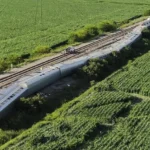Railroad Jobs: The Dispatcher
This is an excerpt from my book, ALL ABOARD–The Complete North American Train Travel Guide.
* * *
Wherever the train may be, its progress is controlled every inch of the way by a dispatcher. The airline equivalent is the air-traffic controller, but there is an important difference: Railroad dispatchers are employees of the individual railroads, while air-traffic controllers are employed by the Federal Aviation Administration (FAA), an agency of the US Department of Transportation. (One more hidden government subsidy of the airline industry not enjoyed by Amtrak, by the way.)
Dispatchers who control trains traveling in the Northeast Corridor between Washington, DC, and Boston are Amtrak employees, because those tracks are owned by Amtrak. Elsewhere throughout the country, the movement of Amtrak trains is controlled by dispatchers employed by the host railroads—that is, the railroads over whose tracks the Amtrak trains travel.
Like their aviation counterparts, dispatchers are critical to the safe operation of the nation’s railroads. Typically, they work in darkened rooms, monitoring the progress of trains on an illuminated display of the tracks for which they are responsible. The job requires complete concentration, and their fellow employees take pains not to interrupt or distract them.
Dispatchers communicate directly with a train’s engineer by radio. They also control the signals seen by the engineer along the route. The dispatcher’s main and constant concern is knowing exactly where each train is at all times. To assist the dispatcher, the engineer checks in by radio regularly—when the train passes specific checkpoints, when it leaves each station, and at other times along the way.
There is other, more specific communication between the train crew and dispatcher, of course. The dispatcher frequently directs the train to slow down, stop, or resume normal speed. He may remind the engineer that there are workers on the track at a certain location or instruct him to reduce speed between two specific mileposts because that track has recently been laid. When receiving such instructions, the engineer will acknowledge the call and carefully repeat the message so the dispatcher will be sure it was heard correctly. The engineer will often conclude his part of the transmission by verbally noting the time and the train number and then identifying himself by name. For important matters, the dispatcher is also the train’s link to the rest of the world. If a passenger becomes seriously ill, for instance, the engineer can call the dispatcher and ask her to arrange for paramedics to meet the train at the next station stop.
To sum it all up, the dispatcher is probably the most critically important job on the safe operations side of the railroad.


